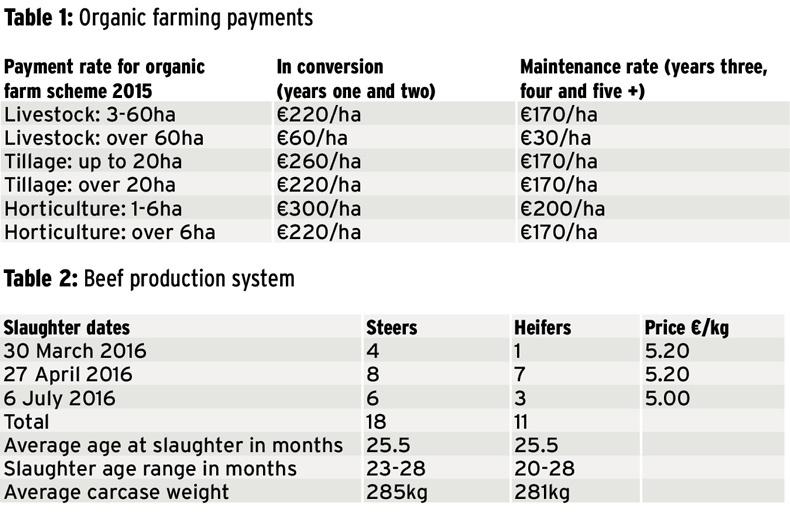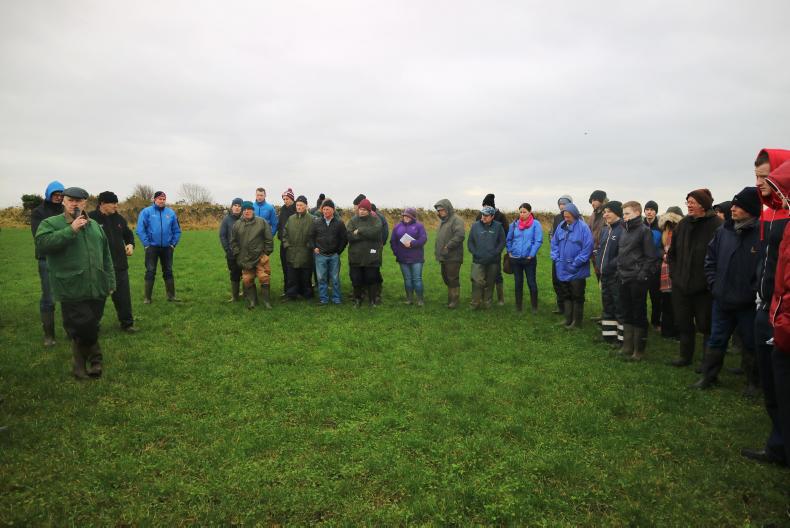Eugene Kirrane, Cullane, Irishtown, Co Mayo, became an organic farmer in 2011. He converted from conventional suckling and beef farming because he was finding it difficult to make a financial margin.
“I was disillusioned with conventional farming for two main reasons – the costs of production and poor conventional beef prices,” said Eugene. He converted his farm in early 2011 and after a two-year conversion period, achieved full organic status in May 2013.
Originally, he was finishing approximately 70 to 90 cattle per annum. He now has a spring-calving suckler enterprise and finishes all progeny on the farm. He said that he is very happy with this system, but it is very much a learning curve so far. A Teagasc open day was held on Eugene’s farm recently where farmers had a chance to see first-hand how he manages his organic farm.
Conversion
The conversion worked out very well for Eugene. Farmers converting from conventional farming to organics are paid at a higher rate for the first two years to help cover the costs of conversion. To start off, Eugene did an introduction to the Organic Farming Scheme (OFS) course with Teagasc. “I found this course invaluable and it really helped me to understand what is involved in organic farming and most of all it allowed me to draw up a business plan for the conversion,” explained Eugene.
Dan Clavin, organic adviser with Teagasc, says if you are thinking about getting into organics you should attend plenty of farm walks and talk to established organic farmers. In 2011, Eugene chose an organic certification body and submitted his conversion plan. The Organic Certification Bodies (OCBs) provide an inspection and certification service for all organic production units in Ireland. They have been designated and are regulated by the Organic Unit of the Department of Agriculture, Food and Marine (DAFM), and are responsible for upholding the organic regulations as defined by the EU.
When his application was approved by the OCB, Eugene was issued with an organic licence number, so he was a registered organic operator. Eugene then successfully applied to DAFM to the Organic Farming Scheme. This scheme is not currently open for applications but it is hoped that it will open later this year. As part of the conversion, a new slatted/straw-bedded shed was built. In organics, housing is not compulsory but where cattle are housed at least 50% of the floor area must be bedded.
Elaine Leavy from Teagasc says farmers should note that animals standing in the yard prior to conversion will never be organic. But any animal born after 12 weeks of the farm entering conversion will be classified as organic once the two-year conversion period elapses. In Eugene’s case he had heifers in calf prior to converting, when these heifers calved down their progeny were classified as organic after the two-year conversion period was up and just in time for sale. Organic payments through the OFS are made annually. These payments depend on the size and type of farm (Table 1).
Soil fertility
Eugene makes targeted use of his slurry and farmyard manure to prevent soil fertility dropping in addition to frequent lime application. With the high percentage of red and white clover in his swards, nitrogen has not been an issue but he has noticed that phosphorus and potassium levels are starting to slide.
Dan Clavin says organic farmers have a number of options available to them to maintain soil fertility levels. They can import slurry from non-intensive conventional farms, poultry manure from free-range or organic poultry farms and farmyard manure or dairy processing residues from licensed processors. They also have the options of spreading sulphate of potash or ground rock phosphate but these can be more expensive alternatives. All importations have to be recorded and justified to the OCB.
Livestock health
An animal health plan was drawn up by Eugene’s vet during the conversion to organic. This specified the health issues on the farm prior to converting and how the problems would be tackled in the future, while fulfilling the requirements of organic certification standards. In organics, the detection of problems needs to be early and timely veterinary advice is invaluable. Where veterinary products are used, withdrawal periods may have to be doubled or tripled depending on the product. Eugene’s normal annual veterinary inputs include a blackleg vaccine for calves and one fluke treatment at housing.
Markets
John Brennan, who is manager at Leitrim Organic Farmers Co-op, says the trade for organic stock is very strong and he believes supply will be tighter from mid-February. He says the price will exceed €5/kg this year. The co-op supplies Slaney Foods with organic cattle weekly where significant price premiums of €1/kg over conventional beef price are frequently paid. John says Angus, Shorthorn, and Aubrac are popular organic breeds and factory agents are ideally looking for carcase weights between 280kg and 300kg, but Slaney Foods will take carcases up to 400kg. This can be explained by the prohibitive costs of winter finishing for organic farmers who buy in organic ration.
The 43.6ha farm is fragmented and is made up of four separate blocks. The home block is used for red clover silage predominantly and the other blocks are used for silage and grazing cows. For the conversion, Eugene started sowing white and red clover. The main reasons for sowing clover were to help meet the forage requirements of the farm, cut out the importation of organic rations (organic rations cost approximately €500/t) and clover has nitrogen fixing abilities, which is beneficial in organic farming.
The red clover silage fields are cut three to four times per year. The first cut is usually taken towards the end of May and the remaining cuts are taken in six- to eight-week intervals. Eugene cuts the silage just before the red flower develops.
Harvesting the silage is done over three days during normal conditions. On day one the crop is cut with a normal disc mower, on day two it is tedded out to allow wilting and it is baled on day three. During the summer, all the cows and calves are generally rotated in a paddock system on 20ha of grazing ground around the home farm which is separated into nine paddocks. In winter, the one- and two-year-old animals are fed the best-quality red clover silage, while the cows are fed medium-quality silage. No meal has been fed to animals since the conversion period with clover silage or grazed grass acting as an adequate finishing diet.
Eugene says finishing stock have an average daily liveweight gain of 1kg. On top of the progeny from Eugene’s suckler herd, he also buys in a further 10 to 12 18-month-old animals in organic sales in Drumshanbo Mart for winter feeding. Table 2 summaries the 2016 slaughter details for the herd.







 This is a subscriber-only article
This is a subscriber-only article









SHARING OPTIONS: